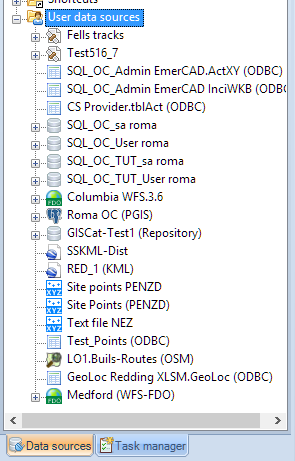Difference between revisions of "Spatial Manager Desktop™ - FAQs: Data sources"
Jump to navigation
Jump to search
| Line 7: | Line 7: | ||
**User data sources (UDS - files or databases): definition and edition of UDSs | **User data sources (UDS - files or databases): definition and edition of UDSs | ||
**Data sources properties: differential icons and properties | **Data sources properties: differential icons and properties | ||
| + | |||
| + | ===What are the User Data Sources (UDSs) in Spatial Manager Desktop™?=== | ||
| + | UDSs are the way you can connect with spatial database servers and also the way you can define the path to a particular spatial data file and its parameters. You can access to UDSs through the "Data sources" panel | ||
| + | |||
| + | [[File:DS-1.PNG]] | ||
==Related links== | ==Related links== | ||
*[http://www.spatialmanager.com/geo-location-of-addresses-using-google-maps-apis/#more-291 Geo-location of addresses using Google Maps APIs] | *[http://www.spatialmanager.com/geo-location-of-addresses-using-google-maps-apis/#more-291 Geo-location of addresses using Google Maps APIs] | ||
Revision as of 20:08, 12 December 2013
Introduction
- Objective of this section
- To become familiar with the different methods defined in Spatial Manager Desktop™ to access spatial data (basic)
- Topics in this section
- Disk drives (files): disk drives or local and network folders
- Shortcuts (files): definition and edition of access to folders
- User data sources (UDS - files or databases): definition and edition of UDSs
- Data sources properties: differential icons and properties
What are the User Data Sources (UDSs) in Spatial Manager Desktop™?
UDSs are the way you can connect with spatial database servers and also the way you can define the path to a particular spatial data file and its parameters. You can access to UDSs through the "Data sources" panel
